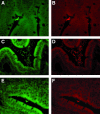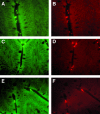Prolonged colonization of mice by Vibrio cholerae El Tor O1 depends on accessory toxins
- PMID: 17698571
- PMCID: PMC2044531
- DOI: 10.1128/IAI.00508-07
Prolonged colonization of mice by Vibrio cholerae El Tor O1 depends on accessory toxins
Abstract
Cholera epidemics caused by Vibrio cholerae El Tor O1 strains are typified by a large number of asymptomatic carriers who excrete vibrios but do not develop diarrhea. This carriage state was important for the spread of the seventh cholera pandemic as the bacterium was mobilized geographically, allowing the global dispersion of this less virulent strain. Virulence factors associated with the development of the carriage state have not been previously identified. We have developed an animal model of cholera in adult C57BL/6 mice wherein V. cholerae colonizes the mucus layer and forms microcolonies in the crypts of the distal small bowel. Colonization occurred 1 to 3 h after oral inoculation and peaked at 10 to 12 h, when bacterial loads exceeded the inoculum by 10- to 200-fold, indicating bacterial growth within the small intestine. After a clearance phase, the number of bacteria within the small intestine, but not those in the cecum or colon, stabilized and persisted for at least 72 h. The ability of V. cholerae to prevent clearance and establish this prolonged colonization was associated with the accessory toxins hemolysin, the multifunctional autoprocessing RTX toxin, and hemagglutinin/protease and did not require cholera toxin or toxin-coregulated pili. The defect in colonization attributed to the loss of the accessory toxins may be extracellularly complemented by inoculation of the defective strain with an isogenic colonization-proficient V. cholerae strain. This work thus demonstrates that secreted accessory toxins modify the host environment to enable prolonged colonization of the small intestine in the absence of overt disease symptoms and thereby contribute to disease dissemination via asymptomatic carriers.
Figures





Similar articles
-
Analysis of Vibrio cholerae genome sequences reveals unique rtxA variants in environmental strains and an rtxA-null mutation in recent altered El Tor isolates.mBio. 2013 Apr 16;4(2):e00624. doi: 10.1128/mBio.00624-12. mBio. 2013. PMID: 23592265 Free PMC article.
-
Hemolysin and the multifunctional autoprocessing RTX toxin are virulence factors during intestinal infection of mice with Vibrio cholerae El Tor O1 strains.Infect Immun. 2007 Oct;75(10):5035-42. doi: 10.1128/IAI.00506-07. Epub 2007 Aug 13. Infect Immun. 2007. PMID: 17698573 Free PMC article.
-
Novel Cholera Toxin Variant and ToxT Regulon in Environmental Vibrio mimicus Isolates: Potential Resources for the Evolution of Vibrio cholerae Hybrid Strains.Appl Environ Microbiol. 2019 Jan 23;85(3):e01977-18. doi: 10.1128/AEM.01977-18. Print 2019 Feb 1. Appl Environ Microbiol. 2019. PMID: 30446560 Free PMC article.
-
Expression of Vibrio cholerae virulence genes in response to environmental signals.Curr Issues Intest Microbiol. 2002 Sep;3(2):29-38. Curr Issues Intest Microbiol. 2002. PMID: 12400636 Review.
-
Epidemiology & molecular biology of Vibrio cholerae O139 Bengal.Indian J Med Res. 1996 Jul;104:14-27. Indian J Med Res. 1996. PMID: 8783504 Review.
Cited by
-
Small molecule-induced allosteric activation of the Vibrio cholerae RTX cysteine protease domain.Science. 2008 Oct 10;322(5899):265-8. doi: 10.1126/science.1162403. Science. 2008. PMID: 18845756 Free PMC article.
-
Analysis of Vibrio cholerae genome sequences reveals unique rtxA variants in environmental strains and an rtxA-null mutation in recent altered El Tor isolates.mBio. 2013 Apr 16;4(2):e00624. doi: 10.1128/mBio.00624-12. mBio. 2013. PMID: 23592265 Free PMC article.
-
Dual-Use Vaccine for Diarrhoeal Diseases: Cross-Protective Immunogenicity of a Cold-Chain-Free, Live-Attenuated, Oral Cholera Vaccine against Enterotoxigenic Escherichia coli (ETEC) Challenge in BALB/c Mice.Vaccines (Basel). 2022 Dec 16;10(12):2161. doi: 10.3390/vaccines10122161. Vaccines (Basel). 2022. PMID: 36560571 Free PMC article.
-
The effects of cholera toxin on cellular energy metabolism.Toxins (Basel). 2010 Apr;2(4):632-48. doi: 10.3390/toxins2040632. Epub 2010 Apr 8. Toxins (Basel). 2010. PMID: 22069603 Free PMC article.
-
Accessory Toxins of Vibrio Pathogens and Their Role in Epithelial Disruption During Infection.Front Microbiol. 2018 Sep 20;9:2248. doi: 10.3389/fmicb.2018.02248. eCollection 2018. Front Microbiol. 2018. PMID: 30294318 Free PMC article. Review.
References
-
- Anderson, A. M., J. B. Varkey, C. A. Petti, R. A. Liddle, R. Frothingham, and C. W. Woods. 2004. Non-O1 Vibrio cholerae septicemia: case report, discussion of literature, and relevance to bioterrorism. Diagn. Microbiol. Infect. Dis. 49:295-297. - PubMed
-
- Bart, K. J., Z. Huq, M. Khan, and W. H. Mosley. 1970. Seroepidemiologic studies during a simultaneous epidemic of infection with El Tor Ogawa and classical Inaba Vibrio cholerae. J. Infect. Dis. 121(Suppl.):S17-S24. - PubMed
-
- Barua, D. 1992. History of cholera, p.1-36. In D. Barua and W. B. Greenough III (ed.), Cholera. Plenum Medical Book Company, New York, NY.
-
- Blake, P. A., R. E. Weaver, and D. G. Hollis. 1980. Diseases of humans (other than cholera) caused by vibrios. Annu. Rev. Microbiol. 34:341-367. - PubMed
Publication types
MeSH terms
Substances
Grants and funding
LinkOut - more resources
Full Text Sources
Other Literature Sources
Molecular Biology Databases

